Strategic Analysis of Starbucks: Management, Industry, and Environment
VerifiedAdded on 2023/04/21
|10
|3256
|320
Report
AI Summary
This report provides a comprehensive analysis of Starbucks' business operations within the coffee industry. It examines the industry landscape, including market share and competition, and outlines Starbucks' mission, vision, and goals. The report delves into the external environment, assessing political, legal, economic, social, environmental, and technological factors impacting the company. Porter’s Five Forces model is applied to evaluate competitive rivalry, bargaining power of customers and suppliers, threat of substitution, and threat of new entrants. Internal factors are explored through SWOT and VRIN analyses, identifying strengths, weaknesses, opportunities, and threats, as well as valuable, rare, inimitable, and non-substitutable resources. The report also touches upon Starbucks' generic strategy and concludes with recommendations for improving business operations. Desklib offers a wealth of resources, including similar reports and study tools, to aid students in their academic pursuits.
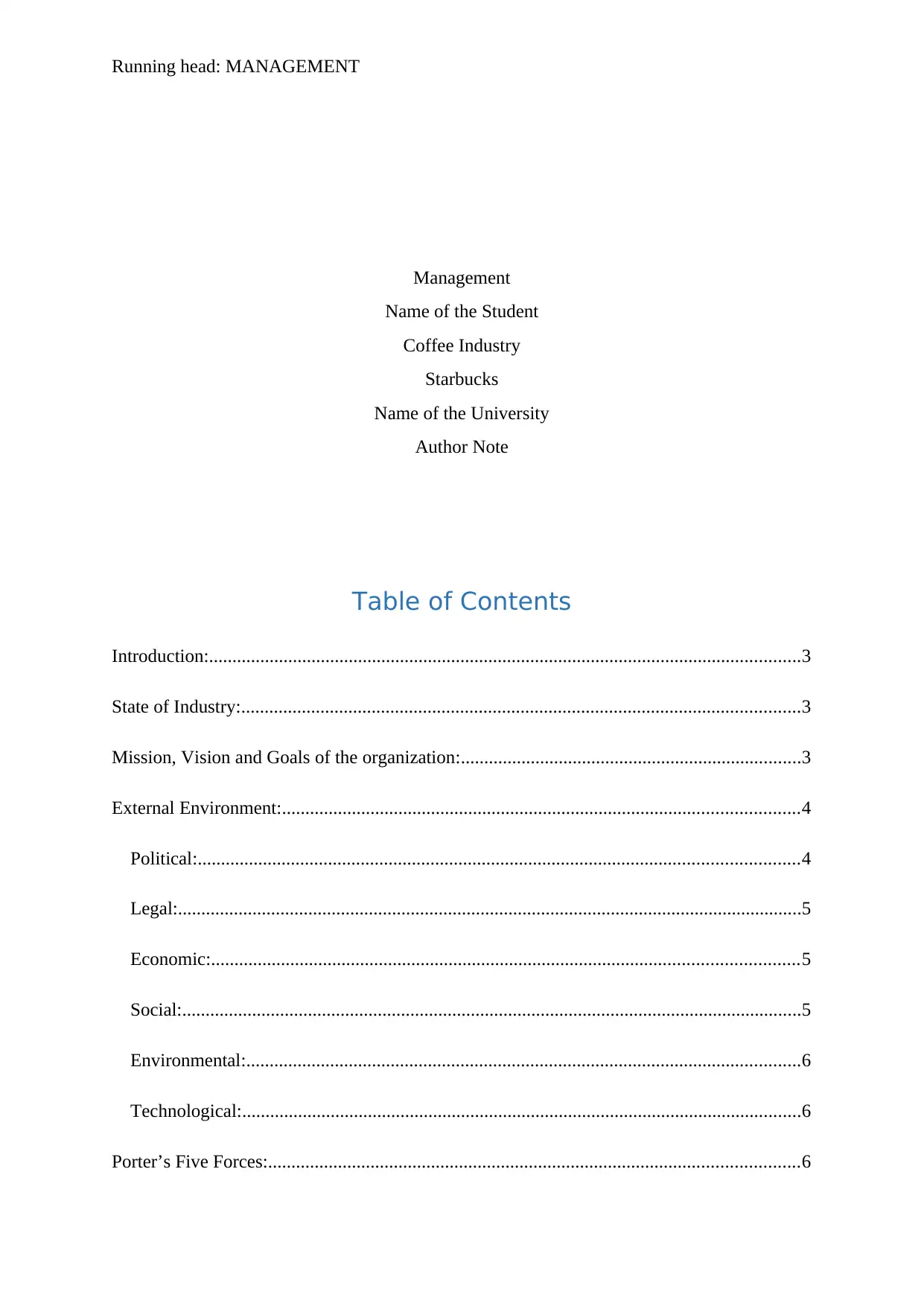
Running head: MANAGEMENT
Management
Name of the Student
Coffee Industry
Starbucks
Name of the University
Author Note
Table of Contents
Introduction:...............................................................................................................................3
State of Industry:........................................................................................................................3
Mission, Vision and Goals of the organization:.........................................................................3
External Environment:...............................................................................................................4
Political:.................................................................................................................................4
Legal:......................................................................................................................................5
Economic:..............................................................................................................................5
Social:.....................................................................................................................................5
Environmental:.......................................................................................................................6
Technological:........................................................................................................................6
Porter’s Five Forces:..................................................................................................................6
Management
Name of the Student
Coffee Industry
Starbucks
Name of the University
Author Note
Table of Contents
Introduction:...............................................................................................................................3
State of Industry:........................................................................................................................3
Mission, Vision and Goals of the organization:.........................................................................3
External Environment:...............................................................................................................4
Political:.................................................................................................................................4
Legal:......................................................................................................................................5
Economic:..............................................................................................................................5
Social:.....................................................................................................................................5
Environmental:.......................................................................................................................6
Technological:........................................................................................................................6
Porter’s Five Forces:..................................................................................................................6
Paraphrase This Document
Need a fresh take? Get an instant paraphrase of this document with our AI Paraphraser
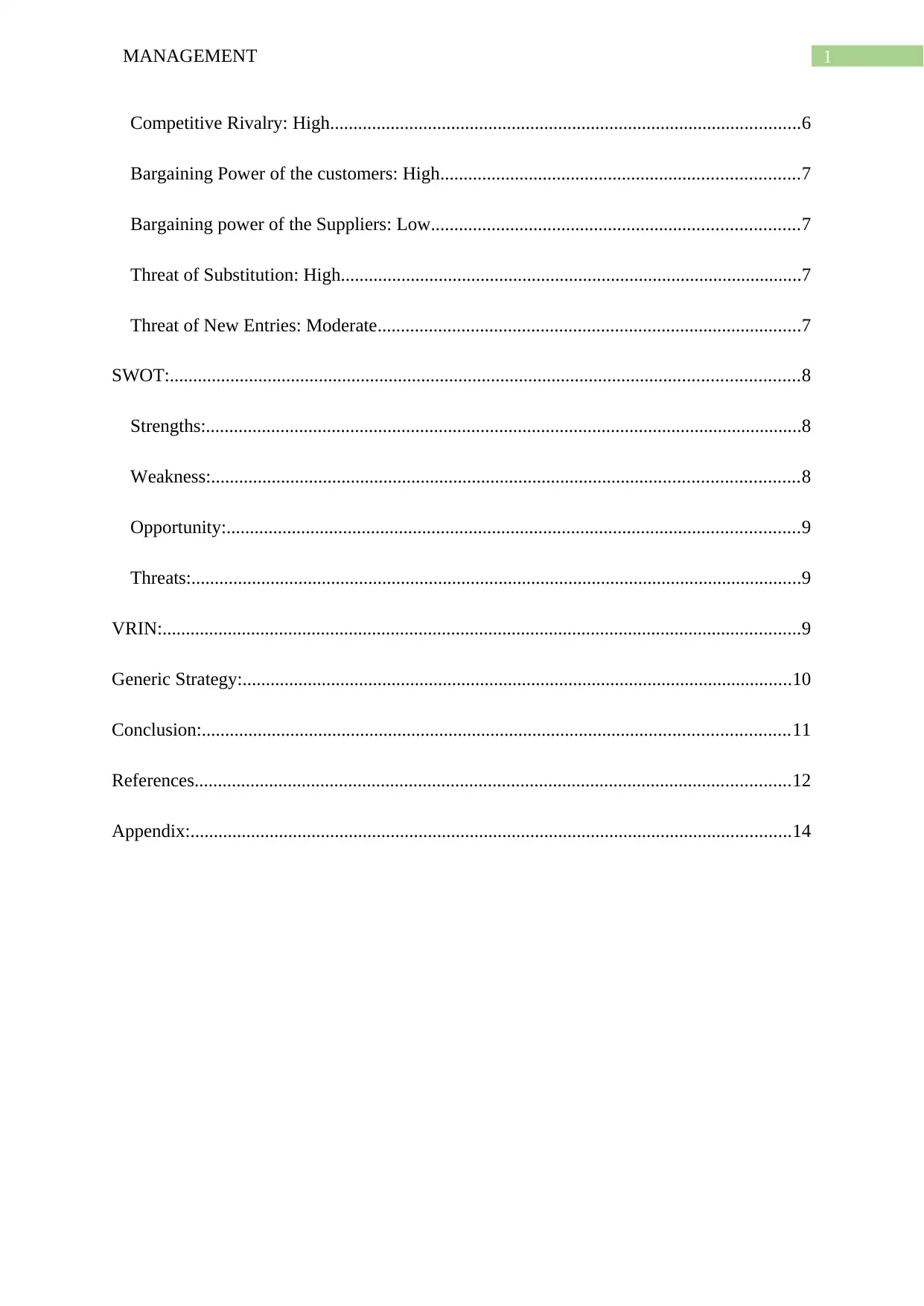
1MANAGEMENT
Competitive Rivalry: High.....................................................................................................6
Bargaining Power of the customers: High.............................................................................7
Bargaining power of the Suppliers: Low...............................................................................7
Threat of Substitution: High...................................................................................................7
Threat of New Entries: Moderate...........................................................................................7
SWOT:.......................................................................................................................................8
Strengths:................................................................................................................................8
Weakness:..............................................................................................................................8
Opportunity:...........................................................................................................................9
Threats:...................................................................................................................................9
VRIN:.........................................................................................................................................9
Generic Strategy:......................................................................................................................10
Conclusion:..............................................................................................................................11
References................................................................................................................................12
Appendix:.................................................................................................................................14
Competitive Rivalry: High.....................................................................................................6
Bargaining Power of the customers: High.............................................................................7
Bargaining power of the Suppliers: Low...............................................................................7
Threat of Substitution: High...................................................................................................7
Threat of New Entries: Moderate...........................................................................................7
SWOT:.......................................................................................................................................8
Strengths:................................................................................................................................8
Weakness:..............................................................................................................................8
Opportunity:...........................................................................................................................9
Threats:...................................................................................................................................9
VRIN:.........................................................................................................................................9
Generic Strategy:......................................................................................................................10
Conclusion:..............................................................................................................................11
References................................................................................................................................12
Appendix:.................................................................................................................................14
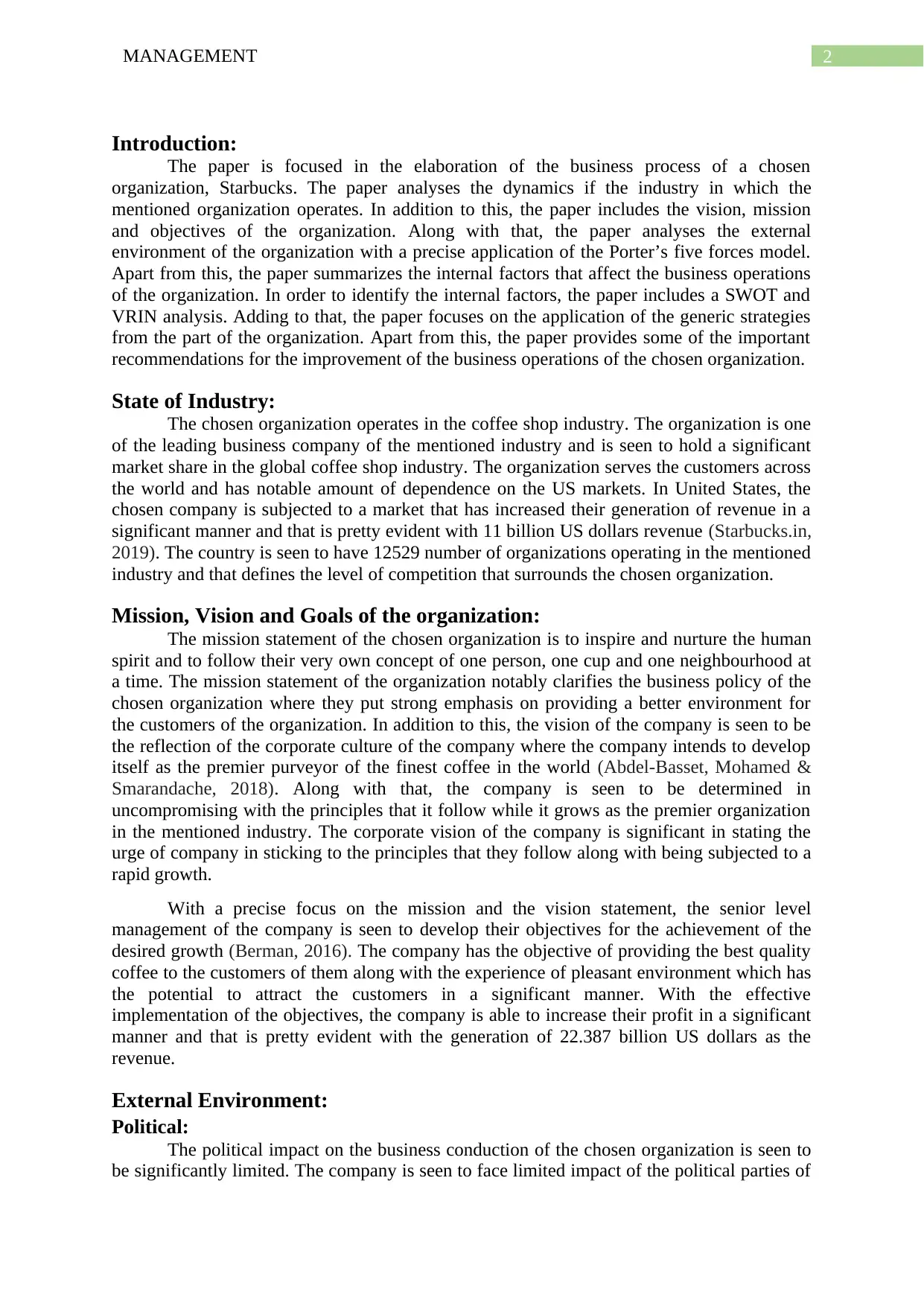
2MANAGEMENT
Introduction:
The paper is focused in the elaboration of the business process of a chosen
organization, Starbucks. The paper analyses the dynamics if the industry in which the
mentioned organization operates. In addition to this, the paper includes the vision, mission
and objectives of the organization. Along with that, the paper analyses the external
environment of the organization with a precise application of the Porter’s five forces model.
Apart from this, the paper summarizes the internal factors that affect the business operations
of the organization. In order to identify the internal factors, the paper includes a SWOT and
VRIN analysis. Adding to that, the paper focuses on the application of the generic strategies
from the part of the organization. Apart from this, the paper provides some of the important
recommendations for the improvement of the business operations of the chosen organization.
State of Industry:
The chosen organization operates in the coffee shop industry. The organization is one
of the leading business company of the mentioned industry and is seen to hold a significant
market share in the global coffee shop industry. The organization serves the customers across
the world and has notable amount of dependence on the US markets. In United States, the
chosen company is subjected to a market that has increased their generation of revenue in a
significant manner and that is pretty evident with 11 billion US dollars revenue (Starbucks.in,
2019). The country is seen to have 12529 number of organizations operating in the mentioned
industry and that defines the level of competition that surrounds the chosen organization.
Mission, Vision and Goals of the organization:
The mission statement of the chosen organization is to inspire and nurture the human
spirit and to follow their very own concept of one person, one cup and one neighbourhood at
a time. The mission statement of the organization notably clarifies the business policy of the
chosen organization where they put strong emphasis on providing a better environment for
the customers of the organization. In addition to this, the vision of the company is seen to be
the reflection of the corporate culture of the company where the company intends to develop
itself as the premier purveyor of the finest coffee in the world (Abdel-Basset, Mohamed &
Smarandache, 2018). Along with that, the company is seen to be determined in
uncompromising with the principles that it follow while it grows as the premier organization
in the mentioned industry. The corporate vision of the company is significant in stating the
urge of company in sticking to the principles that they follow along with being subjected to a
rapid growth.
With a precise focus on the mission and the vision statement, the senior level
management of the company is seen to develop their objectives for the achievement of the
desired growth (Berman, 2016). The company has the objective of providing the best quality
coffee to the customers of them along with the experience of pleasant environment which has
the potential to attract the customers in a significant manner. With the effective
implementation of the objectives, the company is able to increase their profit in a significant
manner and that is pretty evident with the generation of 22.387 billion US dollars as the
revenue.
External Environment:
Political:
The political impact on the business conduction of the chosen organization is seen to
be significantly limited. The company is seen to face limited impact of the political parties of
Introduction:
The paper is focused in the elaboration of the business process of a chosen
organization, Starbucks. The paper analyses the dynamics if the industry in which the
mentioned organization operates. In addition to this, the paper includes the vision, mission
and objectives of the organization. Along with that, the paper analyses the external
environment of the organization with a precise application of the Porter’s five forces model.
Apart from this, the paper summarizes the internal factors that affect the business operations
of the organization. In order to identify the internal factors, the paper includes a SWOT and
VRIN analysis. Adding to that, the paper focuses on the application of the generic strategies
from the part of the organization. Apart from this, the paper provides some of the important
recommendations for the improvement of the business operations of the chosen organization.
State of Industry:
The chosen organization operates in the coffee shop industry. The organization is one
of the leading business company of the mentioned industry and is seen to hold a significant
market share in the global coffee shop industry. The organization serves the customers across
the world and has notable amount of dependence on the US markets. In United States, the
chosen company is subjected to a market that has increased their generation of revenue in a
significant manner and that is pretty evident with 11 billion US dollars revenue (Starbucks.in,
2019). The country is seen to have 12529 number of organizations operating in the mentioned
industry and that defines the level of competition that surrounds the chosen organization.
Mission, Vision and Goals of the organization:
The mission statement of the chosen organization is to inspire and nurture the human
spirit and to follow their very own concept of one person, one cup and one neighbourhood at
a time. The mission statement of the organization notably clarifies the business policy of the
chosen organization where they put strong emphasis on providing a better environment for
the customers of the organization. In addition to this, the vision of the company is seen to be
the reflection of the corporate culture of the company where the company intends to develop
itself as the premier purveyor of the finest coffee in the world (Abdel-Basset, Mohamed &
Smarandache, 2018). Along with that, the company is seen to be determined in
uncompromising with the principles that it follow while it grows as the premier organization
in the mentioned industry. The corporate vision of the company is significant in stating the
urge of company in sticking to the principles that they follow along with being subjected to a
rapid growth.
With a precise focus on the mission and the vision statement, the senior level
management of the company is seen to develop their objectives for the achievement of the
desired growth (Berman, 2016). The company has the objective of providing the best quality
coffee to the customers of them along with the experience of pleasant environment which has
the potential to attract the customers in a significant manner. With the effective
implementation of the objectives, the company is able to increase their profit in a significant
manner and that is pretty evident with the generation of 22.387 billion US dollars as the
revenue.
External Environment:
Political:
The political impact on the business conduction of the chosen organization is seen to
be significantly limited. The company is seen to face limited impact of the political parties of
⊘ This is a preview!⊘
Do you want full access?
Subscribe today to unlock all pages.

Trusted by 1+ million students worldwide
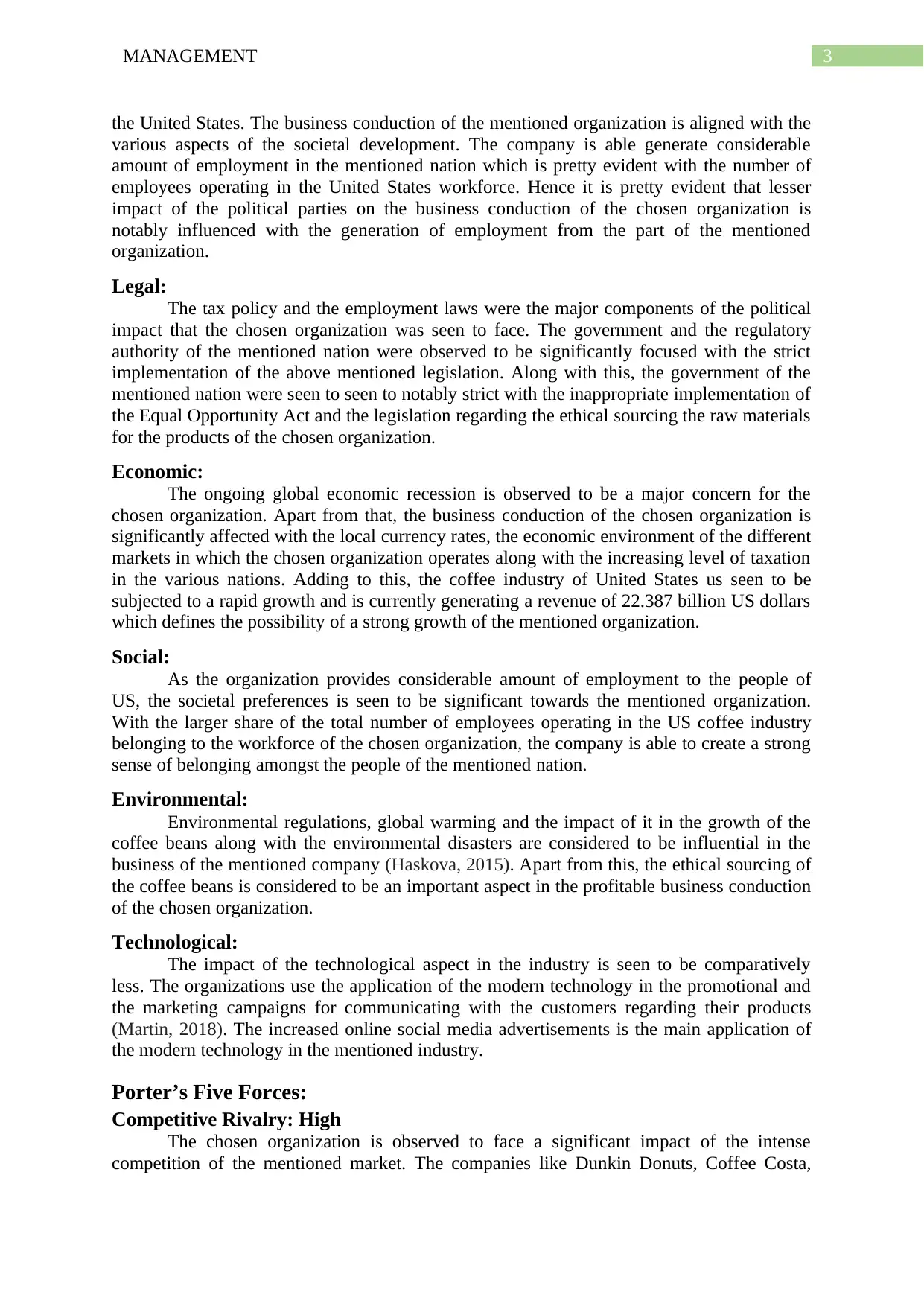
3MANAGEMENT
the United States. The business conduction of the mentioned organization is aligned with the
various aspects of the societal development. The company is able generate considerable
amount of employment in the mentioned nation which is pretty evident with the number of
employees operating in the United States workforce. Hence it is pretty evident that lesser
impact of the political parties on the business conduction of the chosen organization is
notably influenced with the generation of employment from the part of the mentioned
organization.
Legal:
The tax policy and the employment laws were the major components of the political
impact that the chosen organization was seen to face. The government and the regulatory
authority of the mentioned nation were observed to be significantly focused with the strict
implementation of the above mentioned legislation. Along with this, the government of the
mentioned nation were seen to seen to notably strict with the inappropriate implementation of
the Equal Opportunity Act and the legislation regarding the ethical sourcing the raw materials
for the products of the chosen organization.
Economic:
The ongoing global economic recession is observed to be a major concern for the
chosen organization. Apart from that, the business conduction of the chosen organization is
significantly affected with the local currency rates, the economic environment of the different
markets in which the chosen organization operates along with the increasing level of taxation
in the various nations. Adding to this, the coffee industry of United States us seen to be
subjected to a rapid growth and is currently generating a revenue of 22.387 billion US dollars
which defines the possibility of a strong growth of the mentioned organization.
Social:
As the organization provides considerable amount of employment to the people of
US, the societal preferences is seen to be significant towards the mentioned organization.
With the larger share of the total number of employees operating in the US coffee industry
belonging to the workforce of the chosen organization, the company is able to create a strong
sense of belonging amongst the people of the mentioned nation.
Environmental:
Environmental regulations, global warming and the impact of it in the growth of the
coffee beans along with the environmental disasters are considered to be influential in the
business of the mentioned company (Haskova, 2015). Apart from this, the ethical sourcing of
the coffee beans is considered to be an important aspect in the profitable business conduction
of the chosen organization.
Technological:
The impact of the technological aspect in the industry is seen to be comparatively
less. The organizations use the application of the modern technology in the promotional and
the marketing campaigns for communicating with the customers regarding their products
(Martin, 2018). The increased online social media advertisements is the main application of
the modern technology in the mentioned industry.
Porter’s Five Forces:
Competitive Rivalry: High
The chosen organization is observed to face a significant impact of the intense
competition of the mentioned market. The companies like Dunkin Donuts, Coffee Costa,
the United States. The business conduction of the mentioned organization is aligned with the
various aspects of the societal development. The company is able generate considerable
amount of employment in the mentioned nation which is pretty evident with the number of
employees operating in the United States workforce. Hence it is pretty evident that lesser
impact of the political parties on the business conduction of the chosen organization is
notably influenced with the generation of employment from the part of the mentioned
organization.
Legal:
The tax policy and the employment laws were the major components of the political
impact that the chosen organization was seen to face. The government and the regulatory
authority of the mentioned nation were observed to be significantly focused with the strict
implementation of the above mentioned legislation. Along with this, the government of the
mentioned nation were seen to seen to notably strict with the inappropriate implementation of
the Equal Opportunity Act and the legislation regarding the ethical sourcing the raw materials
for the products of the chosen organization.
Economic:
The ongoing global economic recession is observed to be a major concern for the
chosen organization. Apart from that, the business conduction of the chosen organization is
significantly affected with the local currency rates, the economic environment of the different
markets in which the chosen organization operates along with the increasing level of taxation
in the various nations. Adding to this, the coffee industry of United States us seen to be
subjected to a rapid growth and is currently generating a revenue of 22.387 billion US dollars
which defines the possibility of a strong growth of the mentioned organization.
Social:
As the organization provides considerable amount of employment to the people of
US, the societal preferences is seen to be significant towards the mentioned organization.
With the larger share of the total number of employees operating in the US coffee industry
belonging to the workforce of the chosen organization, the company is able to create a strong
sense of belonging amongst the people of the mentioned nation.
Environmental:
Environmental regulations, global warming and the impact of it in the growth of the
coffee beans along with the environmental disasters are considered to be influential in the
business of the mentioned company (Haskova, 2015). Apart from this, the ethical sourcing of
the coffee beans is considered to be an important aspect in the profitable business conduction
of the chosen organization.
Technological:
The impact of the technological aspect in the industry is seen to be comparatively
less. The organizations use the application of the modern technology in the promotional and
the marketing campaigns for communicating with the customers regarding their products
(Martin, 2018). The increased online social media advertisements is the main application of
the modern technology in the mentioned industry.
Porter’s Five Forces:
Competitive Rivalry: High
The chosen organization is observed to face a significant impact of the intense
competition of the mentioned market. The companies like Dunkin Donuts, Coffee Costa,
Paraphrase This Document
Need a fresh take? Get an instant paraphrase of this document with our AI Paraphraser
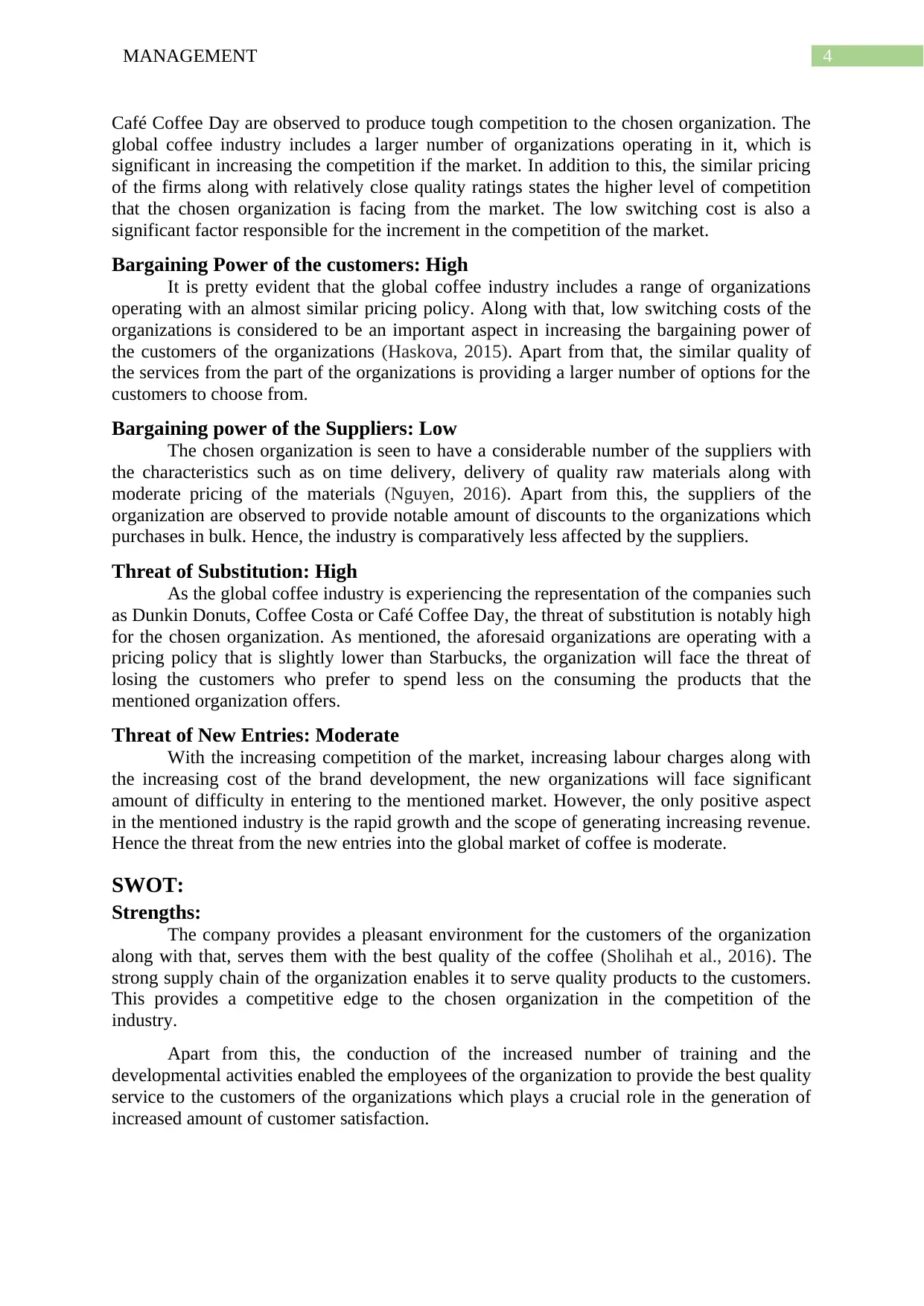
4MANAGEMENT
Café Coffee Day are observed to produce tough competition to the chosen organization. The
global coffee industry includes a larger number of organizations operating in it, which is
significant in increasing the competition if the market. In addition to this, the similar pricing
of the firms along with relatively close quality ratings states the higher level of competition
that the chosen organization is facing from the market. The low switching cost is also a
significant factor responsible for the increment in the competition of the market.
Bargaining Power of the customers: High
It is pretty evident that the global coffee industry includes a range of organizations
operating with an almost similar pricing policy. Along with that, low switching costs of the
organizations is considered to be an important aspect in increasing the bargaining power of
the customers of the organizations (Haskova, 2015). Apart from that, the similar quality of
the services from the part of the organizations is providing a larger number of options for the
customers to choose from.
Bargaining power of the Suppliers: Low
The chosen organization is seen to have a considerable number of the suppliers with
the characteristics such as on time delivery, delivery of quality raw materials along with
moderate pricing of the materials (Nguyen, 2016). Apart from this, the suppliers of the
organization are observed to provide notable amount of discounts to the organizations which
purchases in bulk. Hence, the industry is comparatively less affected by the suppliers.
Threat of Substitution: High
As the global coffee industry is experiencing the representation of the companies such
as Dunkin Donuts, Coffee Costa or Café Coffee Day, the threat of substitution is notably high
for the chosen organization. As mentioned, the aforesaid organizations are operating with a
pricing policy that is slightly lower than Starbucks, the organization will face the threat of
losing the customers who prefer to spend less on the consuming the products that the
mentioned organization offers.
Threat of New Entries: Moderate
With the increasing competition of the market, increasing labour charges along with
the increasing cost of the brand development, the new organizations will face significant
amount of difficulty in entering to the mentioned market. However, the only positive aspect
in the mentioned industry is the rapid growth and the scope of generating increasing revenue.
Hence the threat from the new entries into the global market of coffee is moderate.
SWOT:
Strengths:
The company provides a pleasant environment for the customers of the organization
along with that, serves them with the best quality of the coffee (Sholihah et al., 2016). The
strong supply chain of the organization enables it to serve quality products to the customers.
This provides a competitive edge to the chosen organization in the competition of the
industry.
Apart from this, the conduction of the increased number of training and the
developmental activities enabled the employees of the organization to provide the best quality
service to the customers of the organizations which plays a crucial role in the generation of
increased amount of customer satisfaction.
Café Coffee Day are observed to produce tough competition to the chosen organization. The
global coffee industry includes a larger number of organizations operating in it, which is
significant in increasing the competition if the market. In addition to this, the similar pricing
of the firms along with relatively close quality ratings states the higher level of competition
that the chosen organization is facing from the market. The low switching cost is also a
significant factor responsible for the increment in the competition of the market.
Bargaining Power of the customers: High
It is pretty evident that the global coffee industry includes a range of organizations
operating with an almost similar pricing policy. Along with that, low switching costs of the
organizations is considered to be an important aspect in increasing the bargaining power of
the customers of the organizations (Haskova, 2015). Apart from that, the similar quality of
the services from the part of the organizations is providing a larger number of options for the
customers to choose from.
Bargaining power of the Suppliers: Low
The chosen organization is seen to have a considerable number of the suppliers with
the characteristics such as on time delivery, delivery of quality raw materials along with
moderate pricing of the materials (Nguyen, 2016). Apart from this, the suppliers of the
organization are observed to provide notable amount of discounts to the organizations which
purchases in bulk. Hence, the industry is comparatively less affected by the suppliers.
Threat of Substitution: High
As the global coffee industry is experiencing the representation of the companies such
as Dunkin Donuts, Coffee Costa or Café Coffee Day, the threat of substitution is notably high
for the chosen organization. As mentioned, the aforesaid organizations are operating with a
pricing policy that is slightly lower than Starbucks, the organization will face the threat of
losing the customers who prefer to spend less on the consuming the products that the
mentioned organization offers.
Threat of New Entries: Moderate
With the increasing competition of the market, increasing labour charges along with
the increasing cost of the brand development, the new organizations will face significant
amount of difficulty in entering to the mentioned market. However, the only positive aspect
in the mentioned industry is the rapid growth and the scope of generating increasing revenue.
Hence the threat from the new entries into the global market of coffee is moderate.
SWOT:
Strengths:
The company provides a pleasant environment for the customers of the organization
along with that, serves them with the best quality of the coffee (Sholihah et al., 2016). The
strong supply chain of the organization enables it to serve quality products to the customers.
This provides a competitive edge to the chosen organization in the competition of the
industry.
Apart from this, the conduction of the increased number of training and the
developmental activities enabled the employees of the organization to provide the best quality
service to the customers of the organizations which plays a crucial role in the generation of
increased amount of customer satisfaction.
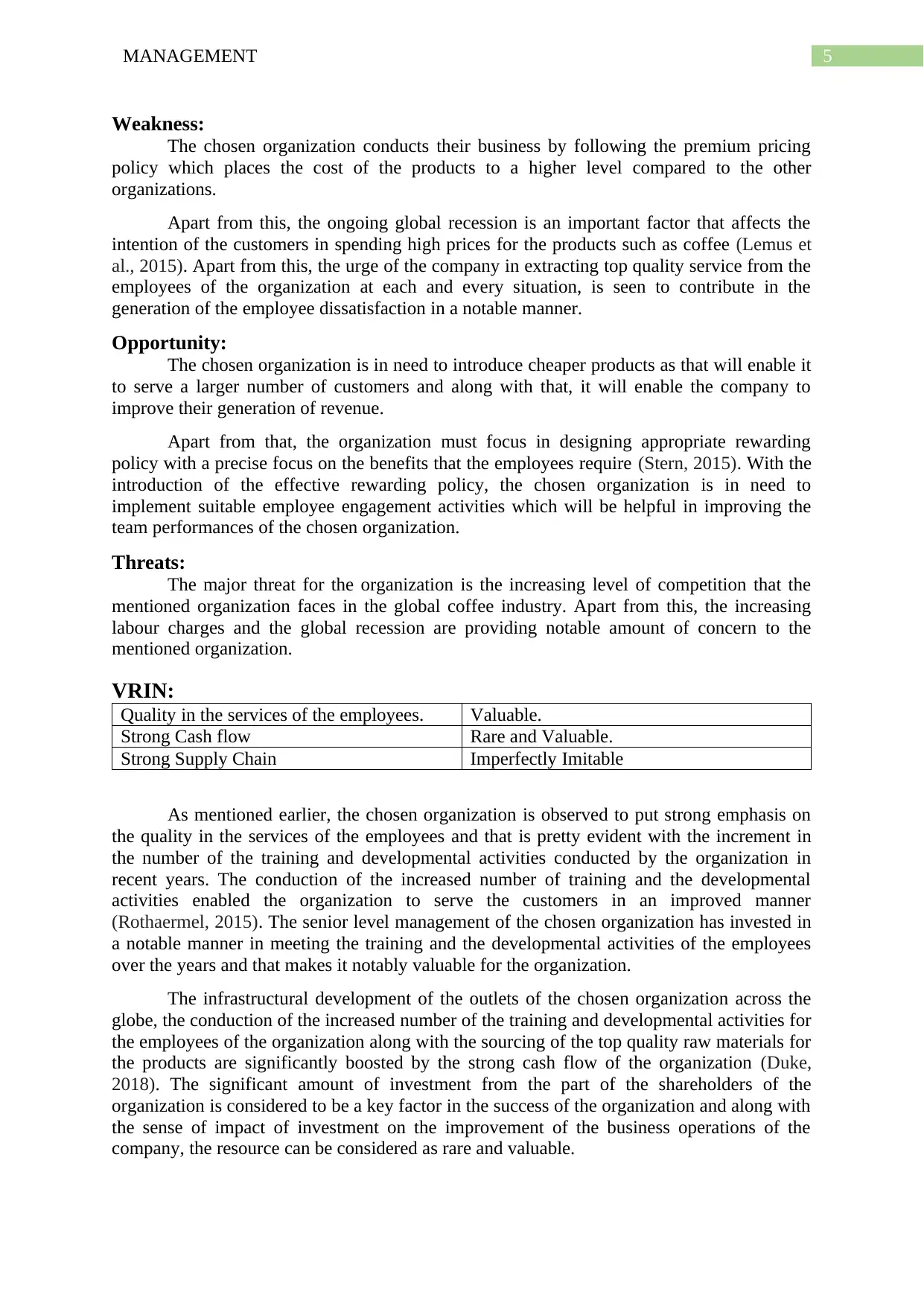
5MANAGEMENT
Weakness:
The chosen organization conducts their business by following the premium pricing
policy which places the cost of the products to a higher level compared to the other
organizations.
Apart from this, the ongoing global recession is an important factor that affects the
intention of the customers in spending high prices for the products such as coffee (Lemus et
al., 2015). Apart from this, the urge of the company in extracting top quality service from the
employees of the organization at each and every situation, is seen to contribute in the
generation of the employee dissatisfaction in a notable manner.
Opportunity:
The chosen organization is in need to introduce cheaper products as that will enable it
to serve a larger number of customers and along with that, it will enable the company to
improve their generation of revenue.
Apart from that, the organization must focus in designing appropriate rewarding
policy with a precise focus on the benefits that the employees require (Stern, 2015). With the
introduction of the effective rewarding policy, the chosen organization is in need to
implement suitable employee engagement activities which will be helpful in improving the
team performances of the chosen organization.
Threats:
The major threat for the organization is the increasing level of competition that the
mentioned organization faces in the global coffee industry. Apart from this, the increasing
labour charges and the global recession are providing notable amount of concern to the
mentioned organization.
VRIN:
Quality in the services of the employees. Valuable.
Strong Cash flow Rare and Valuable.
Strong Supply Chain Imperfectly Imitable
As mentioned earlier, the chosen organization is observed to put strong emphasis on
the quality in the services of the employees and that is pretty evident with the increment in
the number of the training and developmental activities conducted by the organization in
recent years. The conduction of the increased number of training and the developmental
activities enabled the organization to serve the customers in an improved manner
(Rothaermel, 2015). The senior level management of the chosen organization has invested in
a notable manner in meeting the training and the developmental activities of the employees
over the years and that makes it notably valuable for the organization.
The infrastructural development of the outlets of the chosen organization across the
globe, the conduction of the increased number of the training and developmental activities for
the employees of the organization along with the sourcing of the top quality raw materials for
the products are significantly boosted by the strong cash flow of the organization (Duke,
2018). The significant amount of investment from the part of the shareholders of the
organization is considered to be a key factor in the success of the organization and along with
the sense of impact of investment on the improvement of the business operations of the
company, the resource can be considered as rare and valuable.
Weakness:
The chosen organization conducts their business by following the premium pricing
policy which places the cost of the products to a higher level compared to the other
organizations.
Apart from this, the ongoing global recession is an important factor that affects the
intention of the customers in spending high prices for the products such as coffee (Lemus et
al., 2015). Apart from this, the urge of the company in extracting top quality service from the
employees of the organization at each and every situation, is seen to contribute in the
generation of the employee dissatisfaction in a notable manner.
Opportunity:
The chosen organization is in need to introduce cheaper products as that will enable it
to serve a larger number of customers and along with that, it will enable the company to
improve their generation of revenue.
Apart from that, the organization must focus in designing appropriate rewarding
policy with a precise focus on the benefits that the employees require (Stern, 2015). With the
introduction of the effective rewarding policy, the chosen organization is in need to
implement suitable employee engagement activities which will be helpful in improving the
team performances of the chosen organization.
Threats:
The major threat for the organization is the increasing level of competition that the
mentioned organization faces in the global coffee industry. Apart from this, the increasing
labour charges and the global recession are providing notable amount of concern to the
mentioned organization.
VRIN:
Quality in the services of the employees. Valuable.
Strong Cash flow Rare and Valuable.
Strong Supply Chain Imperfectly Imitable
As mentioned earlier, the chosen organization is observed to put strong emphasis on
the quality in the services of the employees and that is pretty evident with the increment in
the number of the training and developmental activities conducted by the organization in
recent years. The conduction of the increased number of training and the developmental
activities enabled the organization to serve the customers in an improved manner
(Rothaermel, 2015). The senior level management of the chosen organization has invested in
a notable manner in meeting the training and the developmental activities of the employees
over the years and that makes it notably valuable for the organization.
The infrastructural development of the outlets of the chosen organization across the
globe, the conduction of the increased number of the training and developmental activities for
the employees of the organization along with the sourcing of the top quality raw materials for
the products are significantly boosted by the strong cash flow of the organization (Duke,
2018). The significant amount of investment from the part of the shareholders of the
organization is considered to be a key factor in the success of the organization and along with
the sense of impact of investment on the improvement of the business operations of the
company, the resource can be considered as rare and valuable.
⊘ This is a preview!⊘
Do you want full access?
Subscribe today to unlock all pages.

Trusted by 1+ million students worldwide
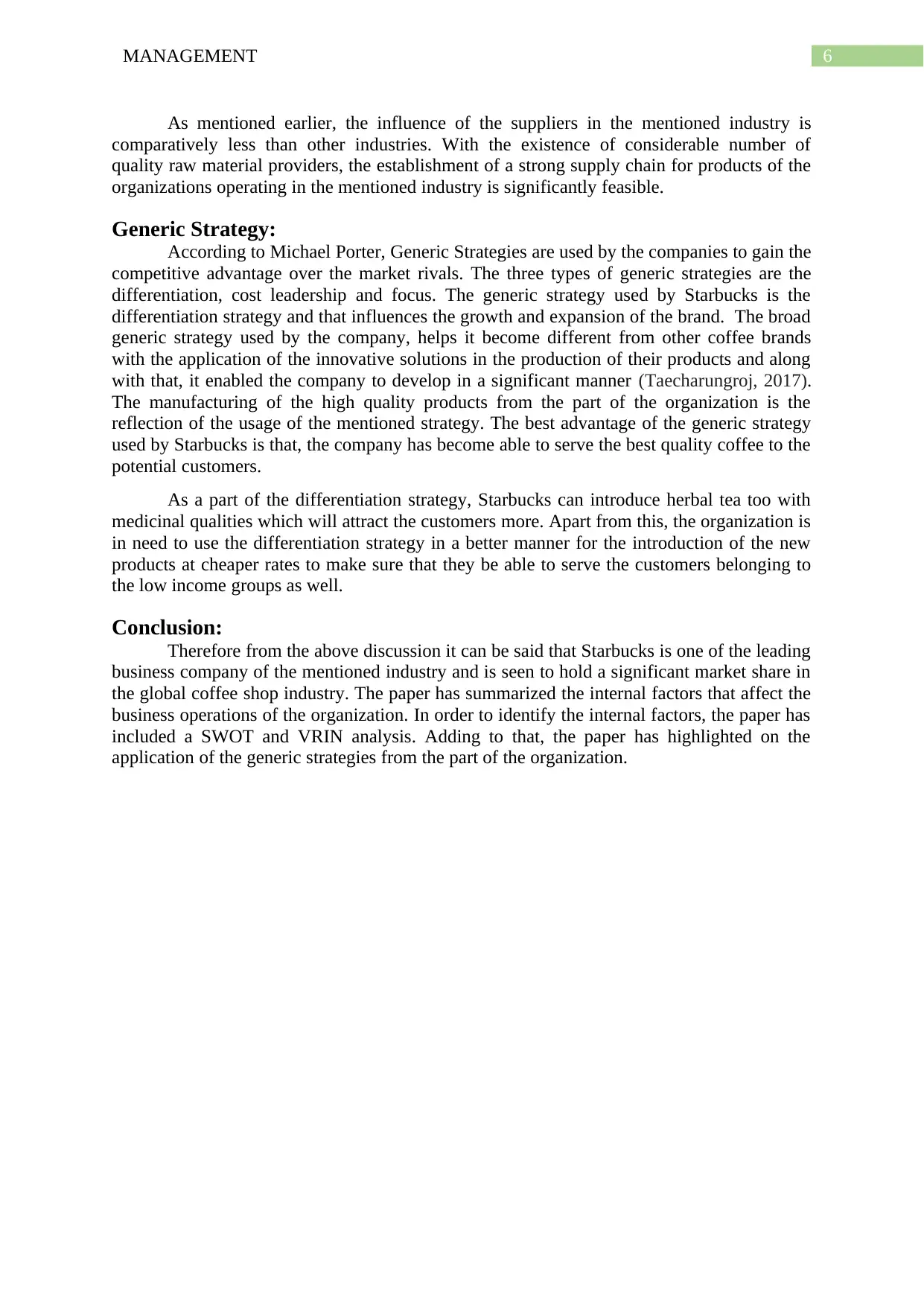
6MANAGEMENT
As mentioned earlier, the influence of the suppliers in the mentioned industry is
comparatively less than other industries. With the existence of considerable number of
quality raw material providers, the establishment of a strong supply chain for products of the
organizations operating in the mentioned industry is significantly feasible.
Generic Strategy:
According to Michael Porter, Generic Strategies are used by the companies to gain the
competitive advantage over the market rivals. The three types of generic strategies are the
differentiation, cost leadership and focus. The generic strategy used by Starbucks is the
differentiation strategy and that influences the growth and expansion of the brand. The broad
generic strategy used by the company, helps it become different from other coffee brands
with the application of the innovative solutions in the production of their products and along
with that, it enabled the company to develop in a significant manner (Taecharungroj, 2017).
The manufacturing of the high quality products from the part of the organization is the
reflection of the usage of the mentioned strategy. The best advantage of the generic strategy
used by Starbucks is that, the company has become able to serve the best quality coffee to the
potential customers.
As a part of the differentiation strategy, Starbucks can introduce herbal tea too with
medicinal qualities which will attract the customers more. Apart from this, the organization is
in need to use the differentiation strategy in a better manner for the introduction of the new
products at cheaper rates to make sure that they be able to serve the customers belonging to
the low income groups as well.
Conclusion:
Therefore from the above discussion it can be said that Starbucks is one of the leading
business company of the mentioned industry and is seen to hold a significant market share in
the global coffee shop industry. The paper has summarized the internal factors that affect the
business operations of the organization. In order to identify the internal factors, the paper has
included a SWOT and VRIN analysis. Adding to that, the paper has highlighted on the
application of the generic strategies from the part of the organization.
As mentioned earlier, the influence of the suppliers in the mentioned industry is
comparatively less than other industries. With the existence of considerable number of
quality raw material providers, the establishment of a strong supply chain for products of the
organizations operating in the mentioned industry is significantly feasible.
Generic Strategy:
According to Michael Porter, Generic Strategies are used by the companies to gain the
competitive advantage over the market rivals. The three types of generic strategies are the
differentiation, cost leadership and focus. The generic strategy used by Starbucks is the
differentiation strategy and that influences the growth and expansion of the brand. The broad
generic strategy used by the company, helps it become different from other coffee brands
with the application of the innovative solutions in the production of their products and along
with that, it enabled the company to develop in a significant manner (Taecharungroj, 2017).
The manufacturing of the high quality products from the part of the organization is the
reflection of the usage of the mentioned strategy. The best advantage of the generic strategy
used by Starbucks is that, the company has become able to serve the best quality coffee to the
potential customers.
As a part of the differentiation strategy, Starbucks can introduce herbal tea too with
medicinal qualities which will attract the customers more. Apart from this, the organization is
in need to use the differentiation strategy in a better manner for the introduction of the new
products at cheaper rates to make sure that they be able to serve the customers belonging to
the low income groups as well.
Conclusion:
Therefore from the above discussion it can be said that Starbucks is one of the leading
business company of the mentioned industry and is seen to hold a significant market share in
the global coffee shop industry. The paper has summarized the internal factors that affect the
business operations of the organization. In order to identify the internal factors, the paper has
included a SWOT and VRIN analysis. Adding to that, the paper has highlighted on the
application of the generic strategies from the part of the organization.
Paraphrase This Document
Need a fresh take? Get an instant paraphrase of this document with our AI Paraphraser
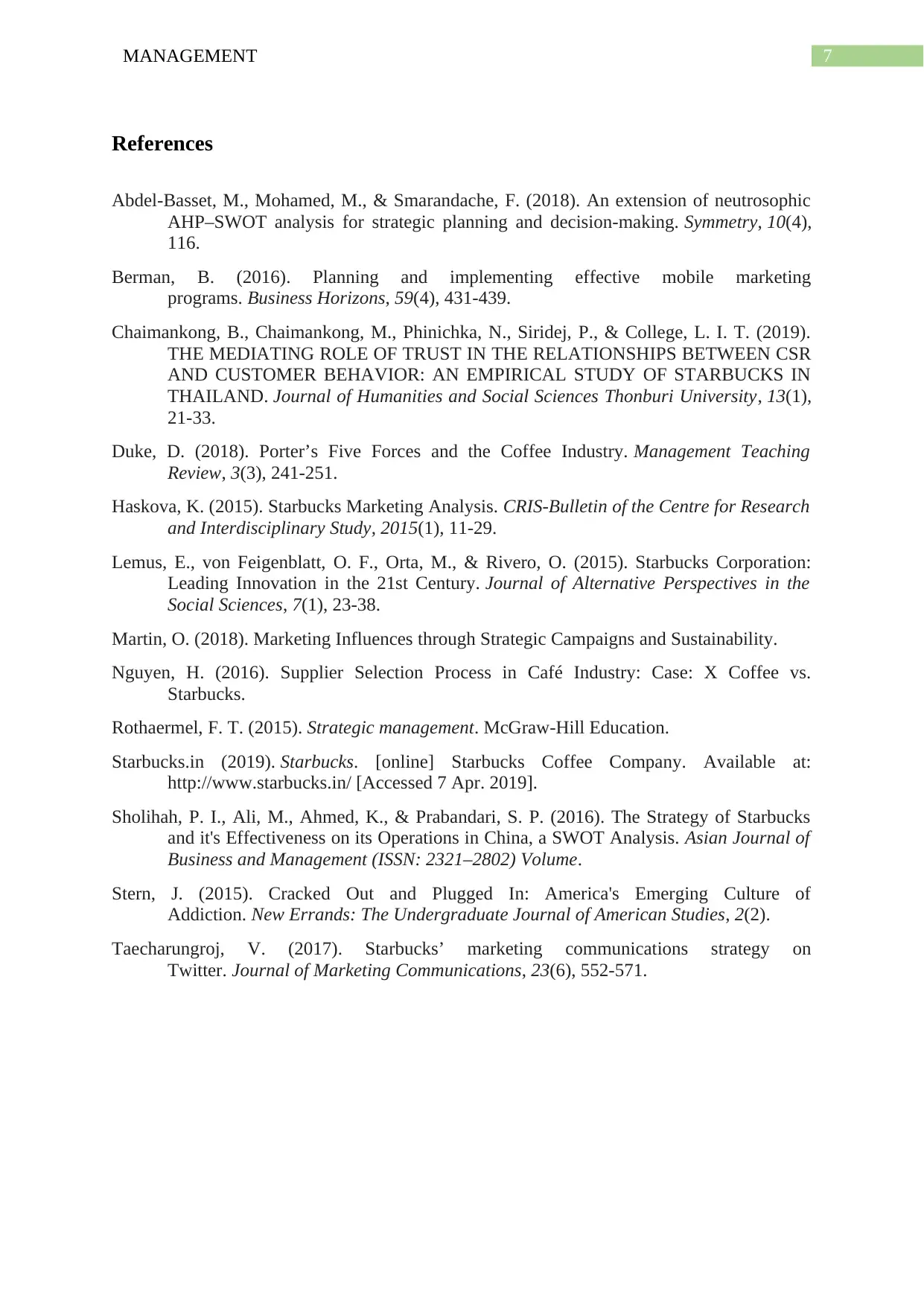
7MANAGEMENT
References
Abdel-Basset, M., Mohamed, M., & Smarandache, F. (2018). An extension of neutrosophic
AHP–SWOT analysis for strategic planning and decision-making. Symmetry, 10(4),
116.
Berman, B. (2016). Planning and implementing effective mobile marketing
programs. Business Horizons, 59(4), 431-439.
Chaimankong, B., Chaimankong, M., Phinichka, N., Siridej, P., & College, L. I. T. (2019).
THE MEDIATING ROLE OF TRUST IN THE RELATIONSHIPS BETWEEN CSR
AND CUSTOMER BEHAVIOR: AN EMPIRICAL STUDY OF STARBUCKS IN
THAILAND. Journal of Humanities and Social Sciences Thonburi University, 13(1),
21-33.
Duke, D. (2018). Porter’s Five Forces and the Coffee Industry. Management Teaching
Review, 3(3), 241-251.
Haskova, K. (2015). Starbucks Marketing Analysis. CRIS-Bulletin of the Centre for Research
and Interdisciplinary Study, 2015(1), 11-29.
Lemus, E., von Feigenblatt, O. F., Orta, M., & Rivero, O. (2015). Starbucks Corporation:
Leading Innovation in the 21st Century. Journal of Alternative Perspectives in the
Social Sciences, 7(1), 23-38.
Martin, O. (2018). Marketing Influences through Strategic Campaigns and Sustainability.
Nguyen, H. (2016). Supplier Selection Process in Café Industry: Case: X Coffee vs.
Starbucks.
Rothaermel, F. T. (2015). Strategic management. McGraw-Hill Education.
Starbucks.in (2019). Starbucks. [online] Starbucks Coffee Company. Available at:
http://www.starbucks.in/ [Accessed 7 Apr. 2019].
Sholihah, P. I., Ali, M., Ahmed, K., & Prabandari, S. P. (2016). The Strategy of Starbucks
and it's Effectiveness on its Operations in China, a SWOT Analysis. Asian Journal of
Business and Management (ISSN: 2321–2802) Volume.
Stern, J. (2015). Cracked Out and Plugged In: America's Emerging Culture of
Addiction. New Errands: The Undergraduate Journal of American Studies, 2(2).
Taecharungroj, V. (2017). Starbucks’ marketing communications strategy on
Twitter. Journal of Marketing Communications, 23(6), 552-571.
References
Abdel-Basset, M., Mohamed, M., & Smarandache, F. (2018). An extension of neutrosophic
AHP–SWOT analysis for strategic planning and decision-making. Symmetry, 10(4),
116.
Berman, B. (2016). Planning and implementing effective mobile marketing
programs. Business Horizons, 59(4), 431-439.
Chaimankong, B., Chaimankong, M., Phinichka, N., Siridej, P., & College, L. I. T. (2019).
THE MEDIATING ROLE OF TRUST IN THE RELATIONSHIPS BETWEEN CSR
AND CUSTOMER BEHAVIOR: AN EMPIRICAL STUDY OF STARBUCKS IN
THAILAND. Journal of Humanities and Social Sciences Thonburi University, 13(1),
21-33.
Duke, D. (2018). Porter’s Five Forces and the Coffee Industry. Management Teaching
Review, 3(3), 241-251.
Haskova, K. (2015). Starbucks Marketing Analysis. CRIS-Bulletin of the Centre for Research
and Interdisciplinary Study, 2015(1), 11-29.
Lemus, E., von Feigenblatt, O. F., Orta, M., & Rivero, O. (2015). Starbucks Corporation:
Leading Innovation in the 21st Century. Journal of Alternative Perspectives in the
Social Sciences, 7(1), 23-38.
Martin, O. (2018). Marketing Influences through Strategic Campaigns and Sustainability.
Nguyen, H. (2016). Supplier Selection Process in Café Industry: Case: X Coffee vs.
Starbucks.
Rothaermel, F. T. (2015). Strategic management. McGraw-Hill Education.
Starbucks.in (2019). Starbucks. [online] Starbucks Coffee Company. Available at:
http://www.starbucks.in/ [Accessed 7 Apr. 2019].
Sholihah, P. I., Ali, M., Ahmed, K., & Prabandari, S. P. (2016). The Strategy of Starbucks
and it's Effectiveness on its Operations in China, a SWOT Analysis. Asian Journal of
Business and Management (ISSN: 2321–2802) Volume.
Stern, J. (2015). Cracked Out and Plugged In: America's Emerging Culture of
Addiction. New Errands: The Undergraduate Journal of American Studies, 2(2).
Taecharungroj, V. (2017). Starbucks’ marketing communications strategy on
Twitter. Journal of Marketing Communications, 23(6), 552-571.
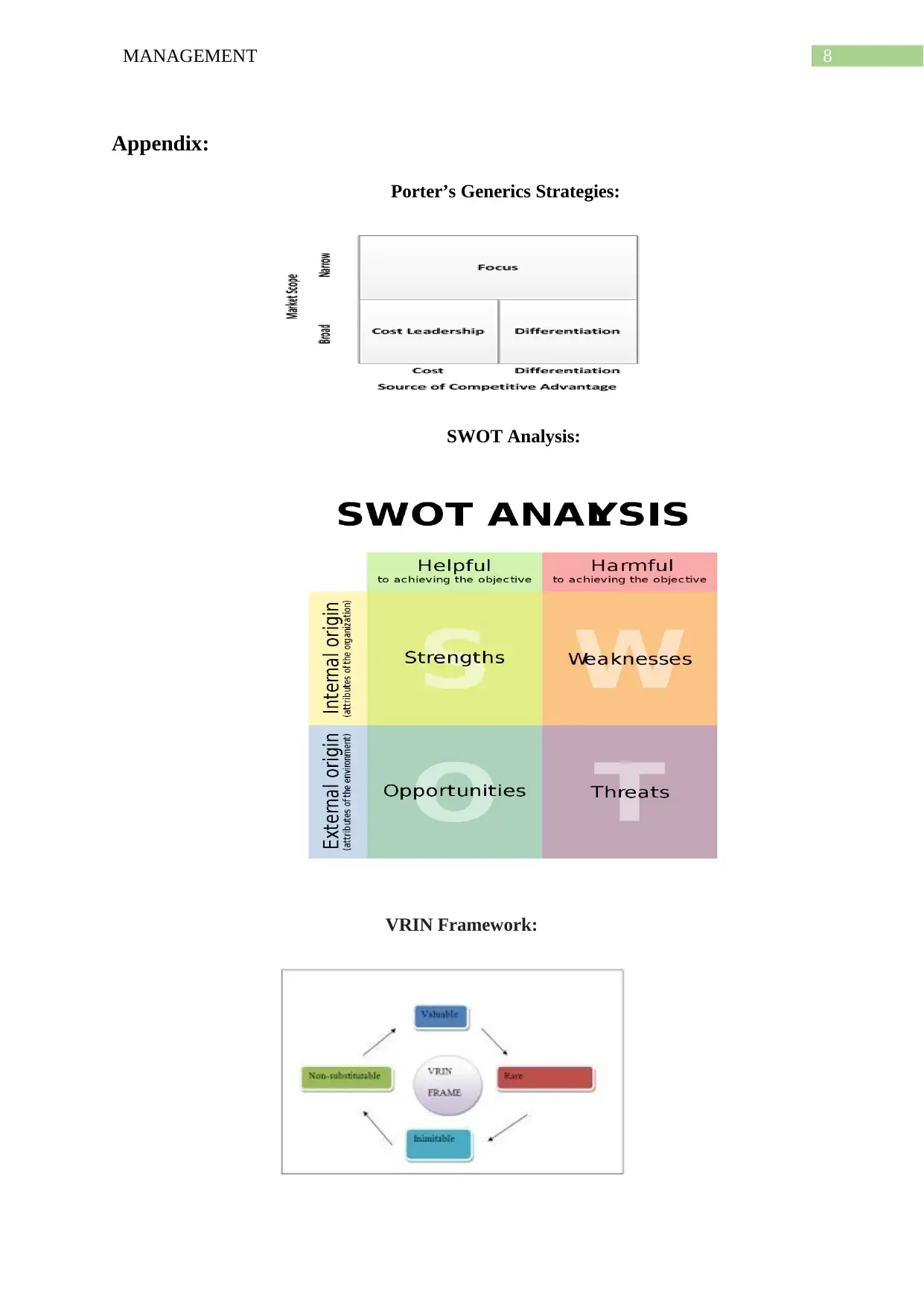
8MANAGEMENT
Appendix:
Porter’s Generics Strategies:
SWOT Analysis:
VRIN Framework:
Appendix:
Porter’s Generics Strategies:
SWOT Analysis:
VRIN Framework:
⊘ This is a preview!⊘
Do you want full access?
Subscribe today to unlock all pages.

Trusted by 1+ million students worldwide
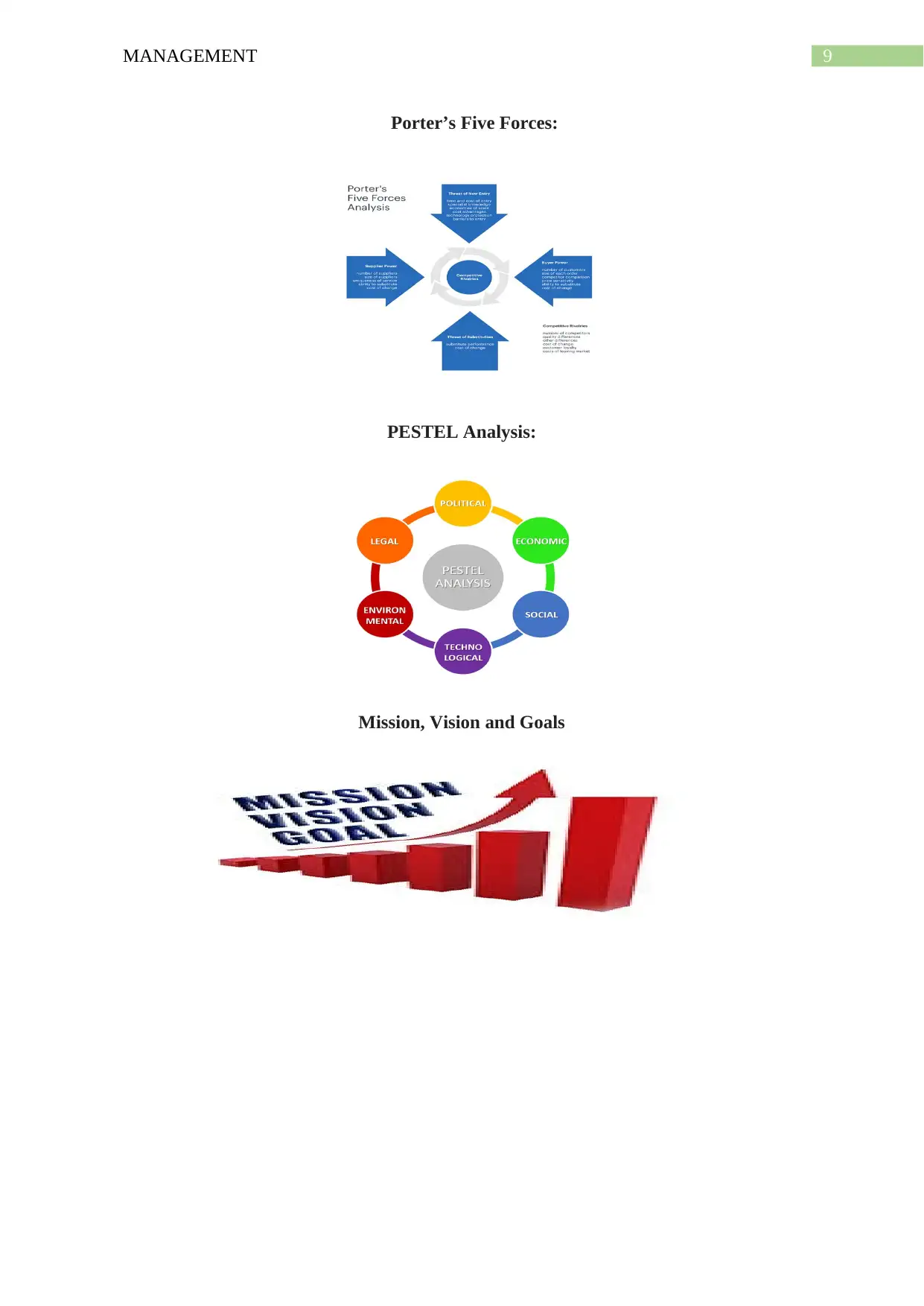
9MANAGEMENT
Porter’s Five Forces:
PESTEL Analysis:
Mission, Vision and Goals
Porter’s Five Forces:
PESTEL Analysis:
Mission, Vision and Goals
1 out of 10
Related Documents
Your All-in-One AI-Powered Toolkit for Academic Success.
+13062052269
info@desklib.com
Available 24*7 on WhatsApp / Email
![[object Object]](/_next/static/media/star-bottom.7253800d.svg)
Unlock your academic potential
Copyright © 2020–2025 A2Z Services. All Rights Reserved. Developed and managed by ZUCOL.





